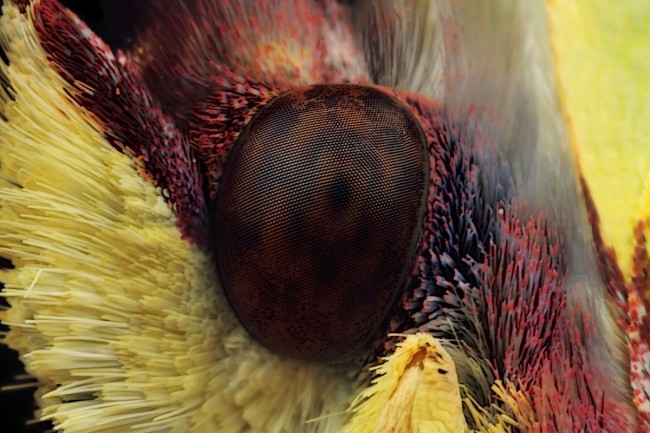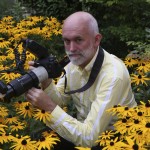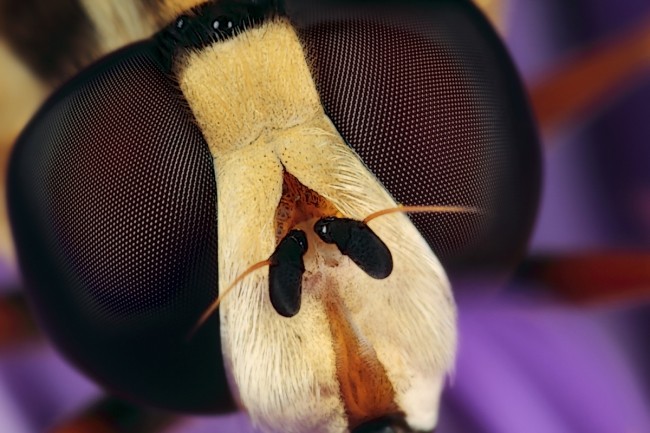One of the most popular books that I read during my childhood was Eric in the Land of the Insects, written by the Dutch author Godfried Bomans. In this humorous fantasy, nine-year-old Eric enters the landscape painting that hangs on his wall and he discovers a world of man-sized wasps, bees, butterflies and other insects that is stunningly similar to the world of humans. The book made such an impression on me that I have always wanted to explore such a world full of wondrous creatures myself. Once photography became a part of my life my world was populated with grasshoppers, spiders, snails, flies, dragonflies and butterflies—Eric’s world.
Macrophotography is restricted to magnifications in the order of 1:10 to 1:1 life-size. When this magnification is reached, shooting from life-size to modest magnifications of up to 20 is called microphotography.

Detail head red mason bee (Osmia rufa): Magnification 6, f/14, ISO 100 and 1/250 sec. © Huub de Waard
A jungle out there
The world of insects, spiders and other small forms can be enjoyed on any beautiful day from early spring until late autumn. I can step out of my house on any sunny morning with a cup of coffee and leisurely browse the garden and see where the action is. Or I can choose my spot and watch and wait. And with a little patience, insects and spiders will show themselves and sometimes seem to pose for the camera. Watching the world of gardens in this way quickly reveals that it is truly “a jungle out there” – a jungle of small predators and preys striving for survival. Walking through any flower garden, you’re likely to see bees, hoverflies, and any number of unrecognized insects flying around or walking upon the petals and blossoms of the beautiful flowers. Microphotography can uncover amazing details of the mysterious world of insects. And yet, this amazing world of insects is right outside the door of virtually every home.
Insects generally have two things in mind: to get on with the task at hand and avoid getting eaten. The task at hand might be finding food, mating, or just basking in the sunshine. This means that insects are somewhat predictable. Bees, butterflies, and similar insects, for example, might be just bumbling about from flower to flower. One of the first things you’ll notice is that some insects are extremely skittish, like butterflies, damselflies, and dragonflies, while others aren’t bothered by your presence at all. You’ll see that some insects are constantly moving about, such as ants and bees, where others prefer to sit still for extended periods – many spiders and assassin bugs. And others still, like leafhoppers and plant hoppers, don’t seem to mind being photographed, but will shyly turn their back on you, forcing you to change position constantly. The point is that you should invest some time getting to know the common behavior of your tiny subjects and how they sense their environment before firing the first frame.

Detail head of male Brimstone butterfly, looking to the left side: Magnification 6, f/14, ISO 100 and 1/250 sec. © Huub de Waard
Approaching Insects
Although most insects do not have orifices in their body for picking up sound vibrations, many use parts of their body, such as their wings, antennae, or special hairs, like TV antennae to detect vibrations in the environment or in the air. Any errant movement on your part could cause you to lose a shot, so be sure to tread carefully when approaching your subjects. Your job is to make yourself non-threatening. The first thing you want to do is to move very slowly. Look before you move, look at where you place your feet, look at where your equipment is, and most of all plan where you are going to put the front of your lens. Many potentially good shots have been ruined by the front of a lens bumping a branch or leaf where an insect was resting, causing it to flee.
Most insects have a view of the world that is very different from ours, because their eyes are built unlike those of vertebrate eyes. Insects such as the housefly, the hornet, the butterfly, and the beetle, have what we call compound eyes. These eyes are made up of many separate units called ommatidia. Each ommatidium samples a small part of the visual field. Having multiple ommatidia allows the animal to easily detect motion. Some, like the dragonfly, have as many as thirty thousand units per eye, each with its own lens. With a compound eye the insect sees a mosaic image. This looks something like the highly magnified dots of a newspaper photograph. Because the lenses in the insect’s eyes have a fixed focus, and can’t be adjusted for distance, insects see shapes poorly.
It is known that insects, especially flying insects, will try to escape from a predator by a simple escape reflex based on the direction and the velocity of a moving shadow or object. If a critical velocity is exceeded, the insect will try to fly away from the direction of the threat. Slow moving objects or shadows often do not trigger this reflex. The lesson learned is that the best way to approach an insect is to move slowly and gently. Most of all, avoid casting your shadow on the insect.
Composition
Composition is more difficult for microphotography than for other types of nature photography.
Your subject might be an insect or a spider sitting on a difficult-to-reach place. Add the fact that you need to approach very carefully to not disturb your subject and you have a bit of a tricky situation. There are no golden rules to help you solve this one. Play around with composition until you get something that works. In microphotography, you want to simplify your image as much as you possibly can. Fill up as much of your frame as possible with the subject. Have your focus as sharp as possible and don’t be afraid to experiment with different angles to find the one with the most aesthetic appeal. Photos at high magnification have a corresponding shallow depth of field, so precise control over the location of focus is critical. This requires not only artistic decisions about what part of the subject should be tack sharp, but also technical decisions about how to make the most of this sharpness.
Photo Credits
All Photographs © Huub de Waard
Gear: Canon 7D, Canon macro lens MP-E 65mm f/2.8, Canon macro Twin Lite Flash MT-E 24EX and
Canon Extender EF 2x (teleconverter) for magnifications larger than 5.
Huub de Waard Photographer Bio
 Huub de Waard is a Dutch wildlife photographer who specializes in insect macro photography. He photographs very small invertebrates so close-up that they are transformed into large subjects.
Huub de Waard is a Dutch wildlife photographer who specializes in insect macro photography. He photographs very small invertebrates so close-up that they are transformed into large subjects.
Through his images he aims to highlight the different characteristics of a variety of species – and their individual charm.
He does not apply focus stacking and all of his pictures are single images made in his own garden.
|Website: HuubdeWaardMacros.com



Please Share Your Thoughts - Leave A Comment!